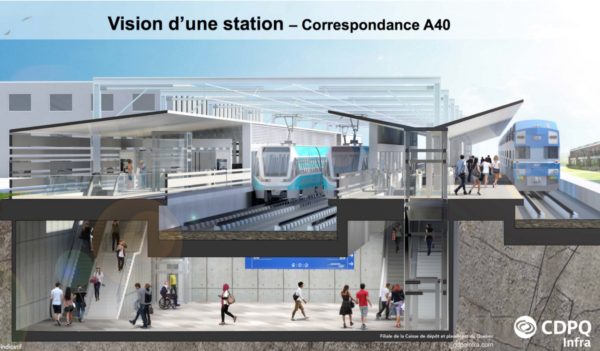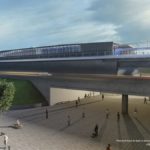The Caisse is Rushing ahead with REM,Ignoring concerns
July 4th, 2016 by ant6n
One of the issues of REM: the Mascouche line would require a transfer rather than routing directly downtown, despite hundreds of millions of investments to achieve that. How this transfer would work operationally is unclear.
Back in April the Caisse de dépôt et placement du Québec announced their REM project to build a large transit line in Montreal, and the initial excitement has worn off as the public has realized many issues with the proposal.
Some of the issues are due to the mandate the government gave the Caisse, and they are not really considering the regional impact. Some issues are due to focussing too strongly on the automated light metro technology, which is incompatible with existing plans and investments. Some are due to planning a project with profitability as the major concern rather than the public interest.
Concerns center on
- How it will negatively affect the regional rail network, notably other lines that need to access the Mont-Royal tunnel.
- The undoing of hundreds of millions in prior investment aimed at bringing several regional lines into the Mont-Royal tunnel, forcing transfers instead.
- The low capacity of the line, i.e. not being able to absorb the ridership from those other lines, and the Caisse’s refusal to publish the ridership studies.
- the potentially expensive construction and routing choices relative to ridership, without a cost drill-down.
- the privatization of public infrastructure, in particular the irreplacable Mont-Royal tunnel. The Caisse will also benefit from hundreds of millions of public investment.
- Whether and how the financing and profitability will work and to what extent the project will take away municipal taxes.
- Rushing the environmental review process.
- Whether the ‘potential’ tunnel stations connecting to Edouard-Montpetit and McGill will ever be built.
These are serious concerns that have been raised from many sides, and should be addressed before pushing ahead.
I’ve personally spoken with representatives of the Caisse. They’ve generally told me not to worry and assured me that the project is still in the planning phase, and that many decisions aren’t set in stone.
However, last week the Caisse has published their “Requests for Qualification†for the REM. The document sets out technical requirements for the construction and operation of the line. This means that the companies that want to build the line and the trains are already starting to work on it, based on this list of requirements. And these requirements ignore all of the raised concerns.
Here’s what we learn:
1. Missing The Tunnel Stations
When I talked to CDPQInfra representatives in person, they kept insisting on the importance of the Tunnel stations at Edouard-Montpetit and McGill. However, there are close to no mentions of the stations in the request for qualification, it only says “It (the REM network) may also offer connections with the Montreal metro green and blue lines and with the Saint-Jérôme commuter line.â€
In effect, the Caisse is pushing ahead without those stations.
2. Little Integration With Existing Lines
At the townhalls, the Caisse floated the idea having several special trains wait for transferees from the Mascouche line, to provide extra capacity for those riders. However the document, only mentions the requirement for schedule integration, i.e. trains should arrive at the same time, but does not appear to require providing extra capacity.
Moreover, the St-Jerome line, which also won’t be able to access the Mont-Royal tunnel and will therefore require a transfer onto the REM, is merely mentioned as potentially having a connection.
3. The Schedule And Resulting Low Capacity
The document specifies peak service as follows:
This implies a maximum capacity of 6,000 PPHD (people per hour per direction) on the Deux-Montagnes line based on 600 passengers per train. Right now the maximum capacity is up to 8,000 PPHD in bursts during peak hours (one train every 15 minutes holding up to 2000 passengers).
Total capacity is 12,000 PPHD. A previous Mont-Royal tunnel station study assumed 27,000 PPHD.
The Maximum possible frequency of the system is specified to be up to every 90 seconds, for a maximum theoretical capacity of 24,000 PPHD (vs over 40,000 for the Montreal Metro, and 60,000 for the Paris RER).
Note that the document does not specify required maximum capacities on each branch, but instead sets the train size and the frequency, instead of letting vendors decide what the most efficient way is to achieve desired capacities.
4. Fixing on Incompatible Technology
Despite explaining at the town halls that the technology will be selected based on need, we’re set on an automated unattended light rail technology, with a specified low capacity, required electrification of 1.5KV, and platform screen doors and 80m trains. The capacity concerns are not addressed. Using this technology will prevent the other heavy rail lines from ever using the tunnels as planned.
The public has spent hundreds of millions towards a regional system around the Mont-Royal tunnel, these investments will be discarded as we’re moving to a less regional system. This system will also not have the capacity to absorb future passengers from the St-Jerome line, the Mascouche line, and the Blue line in order to relieve the overburdened Orange Line.
Choosing a slightly ‘heavier’ technology would allow maintaining compatibility and build towards a regional system, and it would provide more capacity. But this is not what the bidding process specifies.
5. Expensive Rebuilding of the Deux-Montagnes Line
The documents include the expensive conversion of the whole Deux-Montagnes line, removing 15 grade crossings, at maybe tens of millions apiece. It includes complete double-tracking of the line, including building several bridges over rivers. This would be unnecessary if we kept using longer trains with lower frequency in the 10-15 minute range, instead of every 6 minutes and very short trains.
The Deux-Montagnes line was actually re-electrified in the 90es for hundreds of millions of dollars to 25KV, because it is more efficient especially for longer heavy rail lines, any new electrification of heavy rail lines in North America will most likely use 25Kv. Now it will be expensively converted back to 1.5KV, with substations built every 4km, when right now the whole line is powered by one substation.
Back when the work was done in the 90s, the line shut down for several summers to do the conversion. Now the Caisse is claiming the much more substantial work will be possible without shutting down service except for “one or two weekendsâ€.
We Have to Improve the Project
It’s fine for the Caisse to propose a transit project that’s not perfect, but it’s not right to ignore all the concerns raised. These have to be worked out before we push ahead with the project. Even though the Caisse people have previously assured that a lot of the decisions have not been made and that they’re still working on the proposal, the “Request for qualification†basically sets many decisions in stone.
We may end up in a situation where the public will ask for changes, and the Caisse will tell us that it’s too late to change the project, that we’ve had all the suppliers work really hard on this, and if we change everything now they’re not going to be interested in reworking it again, or at least prices will go up.
The REM could be a great transit project for the whole region, but may end up being compromised if the public is presented with a half-baked proposal that doesn’t address our concerns, and our only input is to decide whether we pay for it.




July 5th, 2016 at 21:43
Where has AMT and VIA pushback been on cutting off Mt. Royal tunnel access? I can’t believe they would be blown aside this easily after AMT spent years trying to purchase it from CN. If they can wring a concession of shared access from CDPQ, then CDPQ will be forced to look at mainline-compatible equipment, which in turn will hopefully lead them to adhere to current loading gauges, high platforms, and retention of AC electrification. The usage or potential for high-capacity regional rail stock or even MR-90 compatibility is then assured. The crux of the issue here is a huge gadgetbahn syndrome from people like Andlauer, who see the automated Lyon/Lille light metros as unquestionably importable onto a legacy rail system, which is pretty ironic considering these were directly inspired by the Montreal Metro. And then they decide to spend the least amount of effort designing West Island/Brossard spurs w/o public consultation and negotiation, letting this cutting-edge technology perform lowly park-and-ride duties guaranteed to cause huge mid-day ridership imbalances. It’s incredibly frustrating that no one at CDPQ can simply recognize the RER as the true solution, provided everyone works hard to play nice with CP/CN. But at this stage, hard political maneuvering is probably what’s needed now to get the Caisse off its high horse.
July 5th, 2016 at 23:47
It’s nice to see that you’ve come round to understanding the major flaws present within this billion dollar project. It’s an irresponsible use of public money and I honestly believe that the fixation on light rail and comparison with the SkyTrain is because SNC-Lavalin will be ultimately awarded the contract.
Regardless, here is my alternative to the plan… it involves investment in the metro, primarily and also cost effective use of existing tracks around Montreal.
http://imgur.com/a/MtxCW
July 10th, 2016 at 13:00
I saved your initial REM article in a browser tab, well, pretty much since you published it. Finally read it today and skimmed the subsequent posts. Your realization that this is some sort of fantasy mirrors the same growing realization that took place on another Montreal transit forum in which I participate.
Here’s what I wrote back on 4/25:
“If I were closer to the city, I’d maybe have a better idea of the
point of this whole operation. It’s like they needed a project and
decided to take the constant talk of replacing the XBL on the
Champlain with LRT, the constant talk of an airport train, and the
occasional talk about some sort of train to some point on the West
Island and strung them together as one big project.
“If you accept the premise that this isn’t a real project (like I do!)
then what is it for? Is it for the CDPQ brochure when they go out
looking for business? “Look, we’re experienced – see this plan we’re
doing for Montreal?””
I can’t help but think that this “project” was drawn up for some other reason, maybe to have a “portfolio” of projects to show potential customers in other regions? I am especially excited to see that you *actually* did the math to point out that this is not only a fantasy, but if actually built as drawn (and it’s mostly just renderings) that it would be a *net negative* in terms of transit service provided.
The single most disturbing thing (aside from the hatred of the West Island displayed in some comments on some of the posts here!) is that they (CDPQ) are actually putting these “holds” on property along some of the proposed rights-of-way! Not having lived in Montreal in 30+ years and not being familiar with property rights (or lack thereof) in Canadian law, I was surprised to see what they were able to do (under the US Constitution, doing what they did would constitute a “taking” and require “just compensation” assuming they even had the legal standing to do it in the first place) but once I was past that, it dawned on me that at some level they are serious.
And that’s bad for transit in Montreal.
Keep fighting with facts.
July 10th, 2016 at 15:51
@Peter
It is an actual project, the caisse is following some mandate by the government, the general contract specifying how the government and caissse work together are public, the specific mandate that they got for this particular project is not, at least not in writing. The only thing we have is some PR event with the government saying ‘Champlain, West Island, airport’.
That the Caisse is now doing infrastructure projects in Canada is partly specified by a law passed in the Quebec National Assembly, bill 38: http://www2.publicationsduquebec.gouv.qc.ca/dynamicSearch/telecharge.php?type=5&file=2015C17A.PDF
It says that the ministry of transport will expropriate land ‘on behalf of the Caisse’. Right now there are just land reserves, meaning people can’t sell the land. Presumably these lands will be expropriated later. Some of it looks like land that will be expropriated just so the Caisse can sell it later for more expensive, after the project has finished. Some of this land is on or very close to suppossedly protected agricultural land.
The Caisse is saying they’re not doing this for the real estate development, that they’re just selling development rights. I’m not really convinced.
July 16th, 2016 at 18:41
Given the speed at which the Caisse is proceeding, political intervention would need to be forceful and rapid. Given the (very few) transit-user associations around Montreal, which one is the most effective?
Can automation place further limits on directional capacity? What makes them think that a fully automated system can outdo a system that has trains with human operators? Take a close look at Montreal’s Metro phenomenal PPHD capacity, and the benefit of having human train operators to “rush” a metro train’s progress along the line. The train operator can decide to close the doors without undue delay, and furthermore can switch from automatic to manual driving mode to extract every bit of acceleration and braking from a high-performance train with rubber tires. If you are in doubt, go on YouTube to compare the station dwell times of trains on the Paris automated Metro lines and that of Montreal’s Metro.
I would recommend something off-the-shelf and heavily winterized: A winterized version of the Washington DC Metro or San Francisco BART (both a blend of metro and regional rail) running under 25 kv catenary.